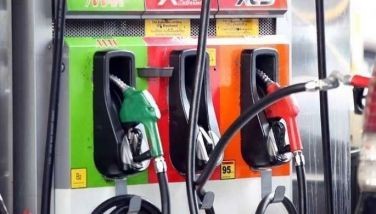YearEnder: The quest for lower power rates continues

Cusi
MANILA, Philippines — The country’s quest to lower electricity rates has become more difficult to achieve with an impending tax imposition on coal, its major source of power, and the regulatory vacuum following the suspension of Energy Regulatory Commission (ERC) commissioners.
Even before these developments, the Philippines already has among the highest rates not only in Asia but also the rest of the world.
Latest available data from the Department of Energy (DOE) showed the country’s power rates are among the highest in Southeast Asia, at par with those in Singapore.
In terms of electricity rates to industries, both countries charge P5.84 per kilowatt-hour (kwh).
But in terms of commercial and household rates, the Philippines has the highest in the region at P7.49 per kwh and P8.90 per kwh, respectively.
Singapore, on the other hand, has a uniform rate of P7.27 per kwh for both commercial and household sectors.
Another report from Capgemini, a French multinational professional services and business consulting firm, showed Philippine average power rates—while it declined 8.9 percent from 2015 to 2016—is still the highest in Asia.
In dollars, the country’s power rate averaged 14.65 cents per kwh, versus Hong Kong’s average rate of 15.10 cents per kwh and Singapore’s 10.89 cents per kwh.
This is mainly because the Philippine government does not subsidize power rates, unlike Thailand, Indonesia and Malaysia.
Morever, taxes, fees, and other charges are tucked in the generation, transmission and distribution rates which constitute Philippine electricity rates.
“There are policy charges. Our power rates are composed of 50 percent generation, 33 percent is wires and 17 percent are policy charges which include taxes, subsidies, feed-in tariff (FIT) rates and universal charges,” Meralco PowerGen Corp. senior vice president Chrysogonus Herrera said.
“Maybe government can fund part of the universal charges for missionary electrification, stranded debts of Napocor (National Power Corp.). Maybe they can use the Malampaya fund to fund it,” he said.
Early on, Energy Secretary Alfonso Cusi already proposed to tap Malampaya funds to pay for Napocor’s stranded costs and debts, instead of passing on the burden to consumers.
Stranded contract costs refer to the excess of Napocor’s contracted cost of electricity with independent power producers over the actual selling price of the output. On the other hand, stranded debts refer to any unpaid financial obligations which have not been liquidated by the proceeds from the sales and privatization of Napocor assets.
Payment for these are covered through the universal charge (UC), a pass-on rate to consumers which is also used to finance missionary electrification and the environmental fund.
The Energy Resource Development Fund, commonly known as the Malampaya fund, has a current balance of P193 billion. This is less than the applications of Power Sector Assets and Liabilities Management Corp. (PSALM) to recover SCC and SD amounting to P233.24 billion from consumers.
But under the Electric Power Industry Reform Act of 2001 (EPIRA), the Malampaya fund is reserved for energy resource development and exploration activities.
“That is in the law but they can always legislate, like stranded cost recovery are part of EPIRA. So it’s a charge legislated. They can also legislate to take it away, funding it from Malampaya,” Herrera said.
Another burden passed on to consumers is the payments to power developers for building the more expensive renewable energy plants, a 20-year incentive scheme under the feed-in tariff (FIT) system.
Currently, consumers are paying 18.30 centavos per kwh to cover FIT payments to developers through an additional bill charge called the FIT-Allowance (FIT-All). Collections are then placed in the FIT-All Fund which is being managed by the National Transmission Corp. (TransCo).
The state-run firm is seeking regulatory approval to raise the FIT-All rate since collections are not enough to cover all payments to developers. TransCo president and CEO Melvin Matibag said the agency has an outstanding balance of P7.1 billion to date.
From the current rate of 18.30 centavos per kwh, TransCo is asking to further hike the rate to 22 centavos per kwh in 2017 and to 29.32 centavos per kwh in 2018.
The applications are still pending at the ERC, which is now facing another problem after the Office of the Ombudsman ordered to suspend commissioners Alfredo Non, Gloria Yap-Taruc, Josefina Patricia Magpale-Asirit and Geronimo Sta. Ana for one year without pay for delaying the conduct of competitive bidding in securing power supply agreements (PSA), which allegedly favored some companies.
This stemmed from a complaint filed by members of Alyansa Para sa Bagong Pilipinas on November 2016 that questioned the deferment of the Competitive Selection Process (CSP).
The CSP policy requires distribution utilities (DUs) and electric cooperatives (ECs) to undertake competitive bidding to secure PSAs with generation companies.
It was supposed to start in Nov. 7, 2015, but the ERC moved the policy’s implementation to April 30, 2016, negating the policies contained under EPIRA and CSP resolutions to protect the interests of consumers.
On the new deadline, PSA applications were filed by Manila Electric Co. (Meralco), the country’s largest power distributor, and other 90 applicants, which has resulted in a number of hearings in Congress.
However, everything is at a virtual halt at the ERC following the suspension order on its commissioners. The agency is already suffering from the corruption allegations on its former chairman and CEO Jose Vicente Salazar and on the whole agency after the suicide of director Francisco Jose S. Villa, Jr. in November 2016.
 Devanadera
DevanaderaERC chairperson and CEO Agnes Devanadera—who just started her official work on Dec. 4—said the one-year suspension order on the four commissioners will paralyze the whole power industry with P1.59 billion worth of pending applications before the agency.
She also warned of possible brownouts in Metro Manila and in the provinces since the long list of pending cases also include the capital spending applications of power distributors.
“As a collegial body, the presence of at least three members of the commission is needed to constitute a quorum to enable the ERC to adopt any ruling, order, resolution, decision or other acts of the commission in the exercise of its quasi-judicial and quasi-legislative functions,” she added.
The ERC is the electric power industry regulator composed of four commissioners and one chairperson. The collegial body requires the presence of three members in order to issue orders, decisions and resolutions.
Power players are already appealing for the speedy resolution of the ERC leadership vacuum, since this will gravely affect the industry.
Philippine Independent Power Producers Association Inc. (PIPPA) said the energy industry needs a fully functional commission in order to effectively implement their mandate in accordance with EPIRA.
“Without a working commission and putting a pause on the important work of the ERC, we will find ourselves without the needed approvals for PSAs (power supply agreements), connection agreements, price determination regulation, compliance certificates and licenses,” it said.
“These are all dependent on the ERC and will negatively impact everyone from the generators, distribution utilities and ultimately to the consumers. As such, we cannot afford any delay on these activities as it will be detrimental to not only to the industry but to each and every consumer who relies on energy security,” PIPPA said.
The ERC is currently seeking guidance from the Office of the President, which is the agency’s appointing authority, on its next steps.
While Devanadera did not make a recommendation, she laid down all the implications of the suspension order on the whole power sector.
Senate Energy Committee chairman Sherwin Gatchalian urged Malacañang to appoint acting commissioners of the ERC during the period of suspension of four of its current commissioners.
In this situation, the lawmaker said the absence of four of its members leaves the body “powerless in making decisions critical to the energy sector.”
According to the Executive Order 292 or the Administrative Code of 1987, the President has the power to temporarily designate a competent person or any official currently in active government service to perform the functions of an official working in the Executive branch who is unable to perform his duties. In which case, the President’s temporary designation should not exceed a period of one year.
“The vacuum of leadership in ERC could result to a standstill in the operations of the collegial body. This will in turn have an effect on our future power supply, resulting to the possibility of blackouts. In this light, I’m urging Malacañang to appoint acting commissioners to perform the duties of the suspended commissioners as soon as possible,” Gatchalian said.
Meanwhile, consumer advocacy group Laban Konsyumer Inc. (LKI) said the four suspended commissioners should resign than paralyze the whole agency and the whole sector.
“The ERC as an institution must continue to fulfill its mandate under the Electricity and Power Industry Reform Act or EPIRA. It’s operation should not be paralyzed. Their duty to the public is clear. Resignation now is an honorable act,” LKI president Victor Dimagiba said.
Starting 2018, consumers will also face higher electricity rates with the imposition of coal tax under the Tax Reform for Acceleration and Inclusion (TRAIN) signed into law by President Duterte.
What was approved was a lower coal excise tax of P50 per metric ton in 2018, P100 in 2019, and P150 in 2020 compared with the original Senate version proposal of a “100-200-300” hike scheme.
While industry players have different computations on its impact on electricity rates, the bottomline is, this will add more burden to consumers.
The Philippines’s dominant fuel source for baseload power is coal, cornering 35 percent of the total installed generating capacity as of end-June 2017. In terms of power generation, coal covers roughly 50 percent of total.
Capgemini’s latest report showed it is also part of the top 30 countries with the highest coal power pipeline expansion plans in Southeast Asia.
Based on the estimates of the Senate energy committee, the coal tax would result in an additional P13.2 billion in electricity costs that consumers would have to shoulder and an average monthly rate increase of P14.348 for a 200 kilowatt-hour (kwh) household served by a 100 percent coal contracted distribution utility.
“The effect is between five to seven centavos per kilowatt-hour for every P100 (per metric ton) increase in tax. This will affect consumers,” Aboitiz Power Corp. president and COO Antonio Moraza said.
Eventually, LKI’s Dimagiba said the amount of taxes for coal will get its way into the prices of goods and services.
But with the coal tax, the Philippine government will be faced with a challenge of balancing the use of coal as power source and in protecting the environment.
“It’s a fine balancing act. I can understand the rationale behind it from a climate change point of view, but we have to take a look at what signal are we sending in terms of the fuel mix for the country. I know we want to go more renewable, but I suppose there must be a balance between conventional and renewable energy,” National Competitive Council (NCC) private sector co-chairman Guillermo Luz said.
Even as the country sources majority of its power requirements from coal, the Philippines only contributes 0.4 percent of carbon emissions globally in 2016, based on Capgemini’s latest report.
The Philippines also is a leader in the region in implanting renewable energy projects, helping the country minimize its carbon emissions.
The report also cited that the country has a five gigawatt (GW) pipeline of wind, solar geothermal, biomass and small hydro projects under development.
“We have to make it clear in our mind that we are ahead in renewable energy development in our region and probably among all other countries worldwide…In fact, our installed capacity is 54 percent and generation at 32 percent from renewable energy,” Cusi said.
With all these challenges at hand, the energy chief has expressed that bringing down power rates has become more difficult, even joking that the way to be competitive with peer countries is if neighbor countries raise their electricity tariff instead.
“Our tariff is already high and we at DOE are trying to find ways to make our electricity more affordable, more competitive. Climate change encourages us to do more renewables which we are already doing…By doing so, we are now ahead in renewable energy development and the penalty is we have higher tariffs, making it uncompetitive in our region,” Cusi said.
He said the ball is now in the court of investors to put their money in countries which have cleaner power source, like the Philippines.
“We hope investors to have positive outlook to countries like with cleaner source of energy,” Cusi said.
- Latest
- Trending
























